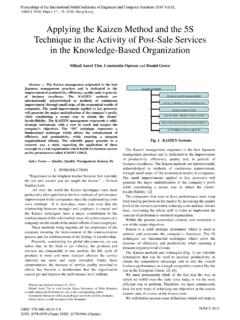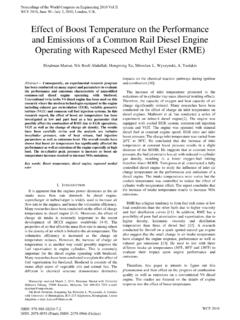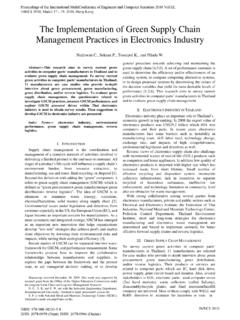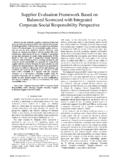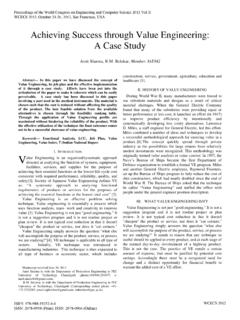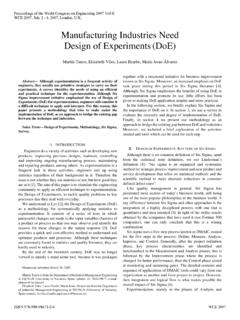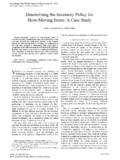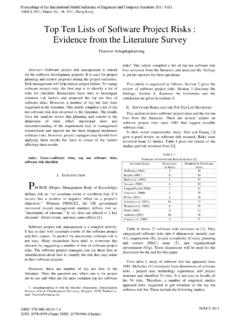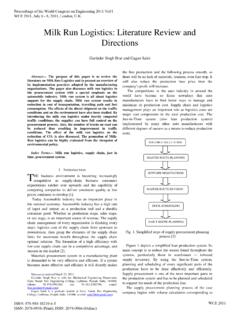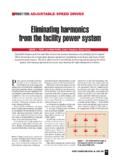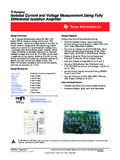Transcription of Comparison between Dire ct-On-Line, Star-Delta …
1 Abstract This paper presents a Comparison between the Direct-On-Line ( ), Star-Delta , and auto -transformer induction motor starting method in terms of power quality . The purpose of this research is to find out the most reliable and practical starting method which has the less power quality problems. These three basic starting methods which differ in their respective wiring connection are the most applicable and widely-used starting method in the industrial area due to its economic reasons. This research is done by analyzing the existed power quality events during the motor starting by using the Fluke power quality Analyzer to capture the waveforms of the events. After the experiments, the three different starting method are being compared to conclude the most suitable and applicable starting method which causes the least severe power quality events.
2 Index Terms Autotransformer, , power quality , Star-Delta . I. INTRODUCTION HE rapid technological progression in these days, both of the electric utilities and end users of electric power are becoming increasingly concerned about the quality of electric power . The increasing emphasis on overall power system efficiency has resulted in continued growth application of devices such as high-efficiency, adjustable-speed motor drives and shunt capacitors for power factor correction to reduce losses. This causes the increases in harmonic levels on power systems and has many people concerned about the future impact on system capabilities [1]. The starting of large motors and their associated loads has always presented an electrical and equipment challenge [2]. The main reason that human are interested in power quality is economic value. Poor power quality may cause electrical appliances malfunction or fuses to trip.
3 Most of these cases happen in the motor starting . During the motor starting , the major problem occurs is the disconnection of the motor itself due to the presence of the power quality problem (voltage sags). As a result, a study of the motor starting needs to be carried out to prove the power quality events. Therefore, the types of power quality events also need to be identified in accordance to the percentage of voltage variations. From this parameter, it can be concluded that whether the types of power quality events may disrupt the motor or affect the power system. Looi is with the Department of Electrical power Engineering, Faculty of Electrical and electronic Engineering, Universiti Tun Hussein Onn Malaysia, Lock Bag 101, 86400 Parit Raja, Batu Pahat, Johor, Malaysia (email: ). Kok and Goh are with the Department of Electrical power Engineering, Faculty of Electrical and Electronic Engineering, Universiti Tun Hussein Onn Malaysia, Lock Bag 101, 86400 Parit Raja, Batu Pahat, Johor, Malaysia (email: and ).
4 II. RESEARCH BACKGROUND power quality [3] is an issue between the compatibility of the supply systems and the loads. Probably the most widely recognized and studied effect of motor starting is the voltage dip that is experienced throughout an industrial power system as the direct result of starting large motors [4]. There are several general methods of starting induction motors: full voltage, reduced voltage, wye-delta, and part winding types. The reduced voltage type can include solid state starters, adjustable frequency drives, and autotransformers [5]. motor starting has been investigated for decades [5-16]. The most frequent power quality events that occur are voltage sags and voltage transients as well as harmonics. Generally, voltage sags occur due to short-circuit faults, however, motor starting is also the main cause of the voltage sags. The starting of industrial-range motors draw a larger current than normal, typically ten times higher than usual, remains until the motor reaches in nominal speed, which takes several seconds to minutes.
5 Evaluating these concerns requires measurement equipment that can capture the voltage sags waveforms over the full duration. The power quality analyzer/meter as well as other tools such as software implementation are need to monitor through the significant events even in just a few milliseconds of time, because the voltage sags is enough to trip a fuse, blinking the lighting systems or even disrupt sensitive equipment. A thorough and detail study of the motor starting should be carried out to identify the voltage sags and their characteristics respectively. III. VOLTAGE SAGS IN motor starting power quality events such as voltage sags and harmonics may occur in motor starting due to the inrush current. Inrush current occurs because the motor will draw six to ten times of current than usual to produce a starting torque.
6 Voltage sags due to the starting of large motors can again be theoretically calculated similar to the one caused by system faults [17]. Fig. 1. Equivalent circuit for induction motor starting The voltage at the PCC is given by the equation: Comparison between Direct-On-Line, Star-Delta and auto -transformer induction motor starting Method in terms of power quality Goh, Looi, and Kok T Proceedings of the International MultiConference of Engineers and Computer Scientists 2009 Vol IIIMECS 2009, March 18 - 20, 2009, Hong KongISBN: 978-988-17012-7-5 IMECS 2009 EZZZVMSMsag+= (1) where is the impedance of the motor under study and is the source impedance. It is realized that these calculations are only for approximations but to have an accurate result of a voltage sag phenomena, a power system analysis package should be used [17].
7 motor starting causes high inrush currents, and the absence of a good understanding of the inrush current which causes the power quality events may spoil the motor or affect the sensitive load at its surrounding. IV. motor starting METHOD Direct-On-Line Starter ( ) starting Method This is the most common starting method available in the market. The components consist of only a main contactor and thermal or electronic overload relay. The disadvantage with this method is that it gives the highest possible starting current. A normal value is between 6 to 7 times the rated motor current but values of up to 9 or 10 times the rated current exist. During a direct-on-line start, the starting torque is also very high, and is usually higher than required for most applications. Star-Delta Starter starting Method This is a starting method that reduces the starting current and starting torque.
8 The components normally consist of three contactors, an overload relay and a timer for setting the time in the star-position ( starting position). The motor must be delta connected during a normal run, in order to be able to use this starting method. The received starting current is about 30 % of the starting current during direct on line start and the starting torque is reduced to about 25 % of the torque available at a start. This starting method only works when the application is light loaded during the start. If the motor is too heavily loaded, there will not be enough torque to accelerate the motor up to speed before switching over to the delta position. When starting up, the load torque is low at the beginning of the start and increases with the square of the speed. When reaching approximately 80-85% of the motor rated speed the load torque is equal to the motor torque and the acceleration ceases.
9 To reach the rated speed, a switch over to delta position is necessary, and this will very often result in high transmission and current peaks. In some cases the current peak can reach a value that is even bigger than for a start. Applications with a load torque higher than 50% of the motor rated torque will not be able to start using the Star-Delta starter. Autotransformer Starter starting Method This is another starting method that reduces the starting current and starting torque but contrary to Star-Delta starting where this starting method needs three wires and three terminals on the motor . Autotransformers are generally equipped with taps at each phase in order to adapt the starting parameters to the application starting requirement. During starting , the motor is connected to the autotransformer taps. With the star and autotransformer contactors closed, the motor is under reduced voltage.
10 Consequently the torque is reduced as the square of the applied voltage. When the motor reaches the 80 to 95% of the nominal speed, the star contactor opens. Then the line contactor closes and the autotransformer contactor opens. The motor is never disconnected from the power supply during starting (closed transition) and reduces transient phenomena. Taps on the autotransformer allow for selection of the motor with 50%, 65%, or 80% of the current inrush seen during a full voltage start. The resulting starting torque will be 25%, 42%, or 64% of full voltage values, as will be the current draw on the line. Thus, the autotransformer provides the maximum torque with minimum line current. V. EXPERIMENTAL WORKS The three types of motor starting method were carried out by using the laboratory workbench. The wiring connection of the motor starting was set up and being monitored by the Fluke power quality Analyzer.
